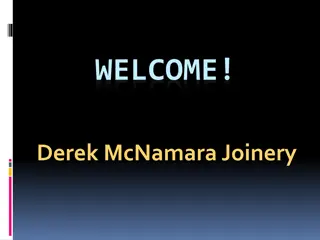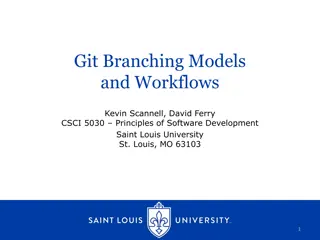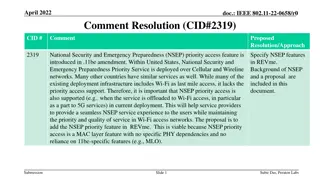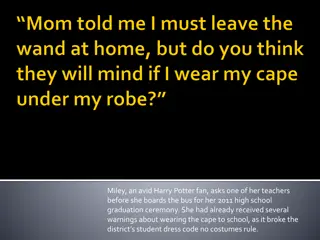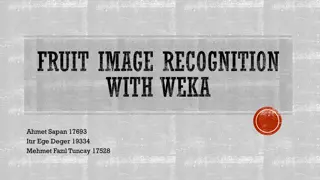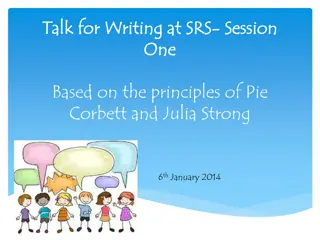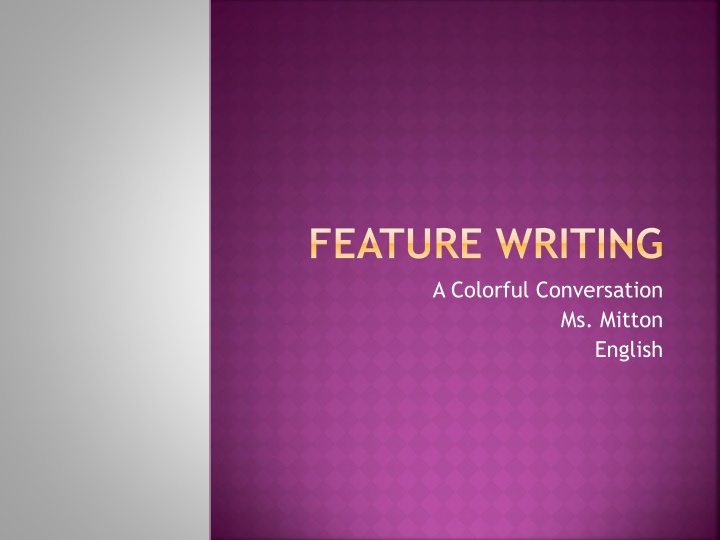
Unveiling the Art of Feature Writing | A Colorful Conversation Guide
Dive into the world of feature writing with Ms. Mitton English as your guide. Learn what sets feature stories apart, how to identify them, and the various structures they can take. Explore the elements of writing style, organizational structure, and news values that define a compelling feature piece. Discover the creative process from brainstorming to editing, and how features can enrich your storytelling arsenal in journalism and beyond.
Download Presentation

Please find below an Image/Link to download the presentation.
The content on the website is provided AS IS for your information and personal use only. It may not be sold, licensed, or shared on other websites without obtaining consent from the author. If you encounter any issues during the download, it is possible that the publisher has removed the file from their server.
You are allowed to download the files provided on this website for personal or commercial use, subject to the condition that they are used lawfully. All files are the property of their respective owners.
The content on the website is provided AS IS for your information and personal use only. It may not be sold, licensed, or shared on other websites without obtaining consent from the author.
E N D
Presentation Transcript
FEATURE WRITING A Colorful Conversation Ms. Mitton English
WHAT IS A FEATURE STORY? Feature stories often focus on issues that are less timely, more personal: trends, relationships, entertainment. News stories tell you what happened; feature stories offer you advice, explore ideas, make you laugh and cry. Tim Harrower
HOW DO I KNOW ITS A FEATURE? Writing Style: features incorporate literary writing techniques that were previously seen as too colorful for newspaper writing. Realistic, intriguing quotations Vivid imagery & sensory details show, don t tell! Alternative perspectives (told through the eyes of characters in the story) Writing style & voice are valued
HOW DO I KNOW ITS A FEATURE? Organizational Structure: features don t use the inverted pyramid style that news stories utilize. Organizational formats can vary More information on this later in this slideshow Topics Covered: lifestyles, health & fitness, food, culture, entertainment & pop culture, homes & gardens grab bag (you never know what topics might come up!)
BUT, IS IT NEWS? Yes Review your news values: Novelty Conflict Impact Timeliness Prominence Proximity Think of an example of a feature for each news value with the person next to you. We will share in a few minutes!
SO, HOW DO I BEGIN? Your reporting methods will be the same: Brainstorming, planning, researching, interviewing, writing, coaching, editing, etc. Features might be stand-alone, or they might be part of a bigger package Could accompany, enhance or complement a news story or package
IS THERE JUST ONE TYPE OF FEATURE? Simply put, no. Features can take a variety of structures. The reporter is charged with knowing and choosing which structure will work best. Consider the topic, angle, purpose and package of the story.
TYPES OF FEATURES GENERAL TOPIC: BLACK FRIDAY/HOLIDAY SHOPPING Type of Feature Personality Profile Human-Interest Story Color Story Backgrounder Trend Story Reaction Piece Flashback How-To Story Consumer Guide Personal Narrative Example Stockers at the local toy store Last-minute/Christmas Eve shoppers The anticipation of waiting in line The history & evolution of Black Friday Online shopping Cyber Monday How people feel about the early store hours How your grandmother used to shop for gifts How to get the best deals on Black Friday The best toy buys for the holidays A shopper s all-nighter experience
TYPES OF FEATURES CONTINUED... YOU & A PARTNER TRY: THE SCHOOL PLAY Type of Feature Personality Profile Human-Interest Story Color Story Backgrounder Trend Story Reaction Piece Flashback How-To Story Consumer Guide Personal Narrative Example
WELL, ITS OBVIOUS THAT IM GOING TO HAVE TO DO THIS. HOW DO I WRITE A FEATURE? Good question. We ll cover three basic organizational structures here: The Wall Street Journal Style (aka the Kabob) Chronological Style Topical Style
SOMEBODY SAID SOMETHING ABOUT KABOBS? The Wall Street Journal Formula or the circle Anecdote Nut Graf Starts specific, gets general, ends where it started Meat Meat Anecdote
CHRONO-WHAT? YOU LOST ME Written in the order that the events occurred order The Lead Nut Graf Clear to write, read Chronology of Events Resonating Quote
ARE THERE ANY OTHER WAYS TO ORGANIZE MY STORY? The Lead The Lead Nut Graf Nut Graf Person 1, Person 2, Person 3 Problem 1, Problem 2, Problem 3 Resonating Quote Resonating Quote By Topic Interview Subject By Topic Issue/Problem
HELP! I CANT STOP WRITING! HOW DO I END THIS BAD BOY? Features should end with a powerful, humorous, meaningful or significant quotation There is the expectation that readers will finish the story, not just look for key information at the start Don t let the ending fizzle, it should pack a punch
ANY OTHER TIPS OR TRICKS? Paint a picture for readers use imagery, dialogue and details. Stay objective! Show readers what is happening, not what you think about it. Ride the line between showing your voice and being a professional journalist. Be clear, concise and consistently good you want to build your readership! Aim for 10-15 paragraphs. Remember, paragraphs should only be one to two sentences long.
UM, I MIGHT WANT TO KNOW MORE. WHERE DID YOU GET THIS INFORMATION? Tim Harrower s Inside Reporting: A Practical Guide to the Craft of Journalism First Edition, 2006




